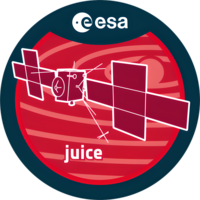Jupiter Icy Moons Explorer
The English used in this article or section may not be easy for everybody to understand. (March 2024) |
Jupiter Icy Moons Explorer (JUICE) is a space probe made by the European Space Agency that will explore Jupiter's major moons, mostly just Ganymede, Europa, and Callisto. It is powered by solar panels, like NASA's Juno (spacecraft).[3]
 Artist's impression of the Juice spacecraft | |||||||||||||||||||||||
| Names | Juice, JUICE | ||||||||||||||||||||||
|---|---|---|---|---|---|---|---|---|---|---|---|---|---|---|---|---|---|---|---|---|---|---|---|
| Mission type | Planetary science | ||||||||||||||||||||||
| Operator | ESA | ||||||||||||||||||||||
| COSPAR ID | 2023-053A | ||||||||||||||||||||||
| SATCAT no. | 56176 | ||||||||||||||||||||||
| Mission duration | Cruise phase: 8 years Science phase: 3.5 years Elapsed: 1 year, 6 months and 12 days | ||||||||||||||||||||||
| Spacecraft properties | |||||||||||||||||||||||
| Manufacturer | Airbus Defence and Space | ||||||||||||||||||||||
| Launch mass | 6,070 kg (13,380 lb)[1] | ||||||||||||||||||||||
| Dry mass | 2,420 kg (5,340 lb)[1] | ||||||||||||||||||||||
| Dimensions | 16.8 x 27.1 x 13.7 meters[1] | ||||||||||||||||||||||
| Power | 850 watts from a solar panel ~85 m2 (910 sq ft)[1] | ||||||||||||||||||||||
| Start of mission | |||||||||||||||||||||||
| Launch date | 14 April 2023 12:14:36 UTC [2] | ||||||||||||||||||||||
| Rocket | Ariane 5 ECA | ||||||||||||||||||||||
| Launch site | Centre Spatial Guyanais, ELA-3 | ||||||||||||||||||||||
| Contractor | Arianespace | ||||||||||||||||||||||
| Flyby of Moon | |||||||||||||||||||||||
| Closest approach | 19 August 2024 | ||||||||||||||||||||||
| Flyby of Earth | |||||||||||||||||||||||
| Closest approach | 20 August 2024 | ||||||||||||||||||||||
| Flyby of Venus | |||||||||||||||||||||||
| Closest approach | 31 August 2025 | ||||||||||||||||||||||
| Flyby of Earth | |||||||||||||||||||||||
| Closest approach | 29 September 2026 | ||||||||||||||||||||||
| Flyby of Earth | |||||||||||||||||||||||
| Closest approach | 18 January 2029 | ||||||||||||||||||||||
| Jupiter orbiter | |||||||||||||||||||||||
| Orbital insertion | July 2031 (planned) | ||||||||||||||||||||||
| Orbital departure | December 2034 (planned) | ||||||||||||||||||||||
| Ganymede orbiter | |||||||||||||||||||||||
| Orbital insertion | December 2034 (planned) | ||||||||||||||||||||||
| Orbit parameters | |||||||||||||||||||||||
| Periapsis | 500 km (310 mi) | ||||||||||||||||||||||
| Apoapsis | 500 km (310 mi) | ||||||||||||||||||||||
| |||||||||||||||||||||||
 Juice mission insignia | |||||||||||||||||||||||
The spacecraft launched on 14 April 2023. It will reach Jupiter in July 2031 after four gravity assists and eight years of travel.[4]
It will fly near the moons before going into orbit around Ganymede.[5]
JANUS- An optical camera system
MAJIS- Moon and Jupiter imaging Spectrometer
GALA- Ganymede laser Altimeter
J-Mag- A magnetometer for JUICE
RPWI- Radio & Plasma Wave Investigation
UVS- UV imaging Spectrograph
SWI- Sub-millimeter Wave Instrument
RIME- Radar for Icy Moons Exploration
PEP- Particle Environment Package
3GM- Gravity & Geophysics of Jupiter and Galilean Moons
History
changeJuice builds on the previously proposed Europa Jupiter System Mission (EJSM-Laplace), a planned collaborative mission between ESA and NASA that would have carried out an in-depth study of the Jovian system and its icy moons. It is now foreseen that the Juice and NASA Europa Clipper spacecraft will be exploring the Jovian system simultaneously.[6]
Milestones JUICE will achieve
change- It will be the first spacecraft to orbit a moon in the outer solar system(Ganymede)
- Juice’s flyby of the Earth-Moon system, known as a Lunar-Earth gravity assist (LEGA), is a world first: by performing this maneuver — a gravity assist flyby of the Moon followed just 1.5 days later by one of Earth—Juice will be able to save a significant amount of fuel.[6]
Spacecraft structure
changeThree-axis stabilized with 10 solar panels and a 2.5-metre-long High Gain Antenna, with a dry mass of approximately 2400 kg and a wet mass (including fuel) of approximately 6000 kg. Each solar panel measures about 2.5 m x 3.5 m; with five on each side of the spacecraft deployed as two distinctive cross-shaped arrays, these total an area of about 85 square meters.
Journey
changeJuice will spend approximately eight years cruising to Jupiter, during which it will complete fly-bys of Venus, Earth and the Earth-Moon system. It will reach Jupiter in July 2031; six months before entering orbit around Jupiter, Juice will begin its nominal science phase. The spacecraft will go on to spend many months orbiting Jupiter, completing fly-bys of Europa, Ganymede and Callisto, and finally conducting an orbital tour of Ganymede.[6]
Details
change| Details about the JUICE mission | |
|---|---|
| Life time | 4yrs. |
| Launch | Kourou, French guinia |
| Rocket | Ariane 5 |
| Launch date | April 13, 2023 |
| Launch Time | 12:15UTC (8:15am EDT) (5:35pm IST) |
References
change- ↑ 1.0 1.1 1.2 1.3 "NASA – NSSDCA – Spacecraft – Details". NASA Space Science Data Coordinated Archive. Archived from the original on 10 November 2021. Retrieved 16 April 2023. This article incorporates text from this source, which is in the public domain.
- ↑ "European Space Agency: Blast off for Jupiter icy moons mission". BBC News. 14 April 2023. Archived from the original on 14 April 2023. Retrieved 14 April 2023.
- ↑ Greicius, Tony (2015-02-13). "Juno - Mission to Jupiter". NASA. Retrieved 2022-11-09.
- ↑ "European Space Agency: Blast off for Jupiter icy moons mission". BBC News. 14 April 2023. Retrieved 14 April 2023.
- ↑ "Juice factsheet". www.esa.int. Retrieved 2022-11-09.
- ↑ 6.0 6.1 6.2 6.3 "Juice factsheet". www.esa.int. Retrieved 2023-04-13.